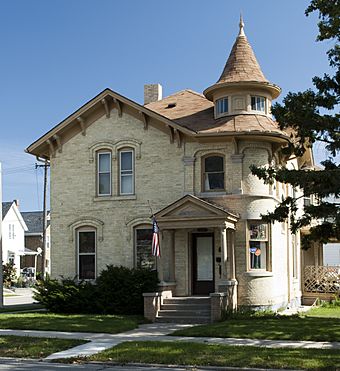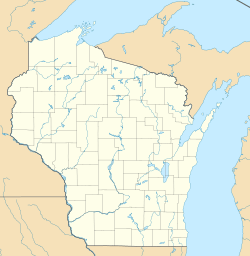Karel Jonas House facts for kids
Quick facts for kids |
|
|
Karel Jonas House
|
|

The Jonas House in 2012
|
|
| Location | 1337 N. Erie Street Racine, Wisconsin |
|---|---|
| Area | 0.25 acres (0.10 ha) |
| Built | 1878 |
| Architectural style | Italianate |
| NRHP reference No. | 82000700 |
| Added to NRHP | March 1, 1982 |
The Karel Jonas House, also known as the Terry B. Vetter House, is a special old home in Racine, Wisconsin. It was once the home of Karel Jonas, a famous journalist, politician, and diplomat. This house was built in 1878 and is now listed on the National Register of Historic Places. This means it's an important building in American history.
Contents
Who Was Karel Jonas?
Karel Jonas was born in 1840 in a small village called Malešov. This village was in Bohemia, which was part of the Austrian Empire at the time. His family made sure he got a good education. He grew up to become a journalist who wrote about politics.
A Bold Young Journalist
In 1860, Karel Jonas wrote something important. He criticized the way schools were run in the Austrian Empire. He felt they treated German students better than Slavic students. Because of this, the authorities took away all copies of his writing. They also kicked him out of school. To stay safe, Karel Jonas had to escape to London.
Life in America
In 1863, Karel Jonas moved to Racine, Wisconsin. He came to work as the editor of a new newspaper. This newspaper was called Slavie, and it was written in the Czech language. The next year, he married Kristina Korizek. Her father had started the Slavie newspaper.
Supporting the Union
During the American Civil War, Karel Jonas and his newspaper supported the Union side. They also supported the Republican Party. In 1870, he went back to Europe to report on the Franco-Prussian War. After that war ended, he secretly visited Prague for a few months. He wrote more articles there. But he had left Austria without permission many years before. So, he soon returned to America.
Helping Czech Immigrants
Back in Racine, Karel Jonas kept publishing his newspaper. He became a very important leader for Czech-Americans. He worked hard to help Czech immigrants get used to life in the U.S. and learn English. He even created a special book to help young Czechs learn to read. He also made the first known Czech-English dictionary.
Karel Jonas's Political Career
As time went on, Karel Jonas's political views changed. He started to support the Democratic Party. In 1876, he won a seat on Racine's city council. He represented the fourth ward, which had many Czech residents. From 1878 to 1880, he was the president of this council. In 1877, he was elected to the Wisconsin assembly. There, he worked to help workers and focused on stopping child labor.
Building the Jonas House
In 1878, Karel Jonas and his wife Kristina built the house we are talking about. The house looks a bit unique today. But when it was first built, it looked more typical for its time. It was a two-story brick house with a style called Italianate. It had arched windows and a deep roof with decorative supports. The main entrance was on the side.
State and Diplomatic Roles
In 1885, Karel Jonas won a seat in the Wisconsin State Senate. Two years later, in 1887, he became a diplomat. He was appointed as a consul in Prague, his beloved hometown. As a consul, he helped increase trade between the U.S. and the region. He also shared American farming ideas with Czech farmers.
After a change in the U.S. government, he returned to Wisconsin. In 1890, Karel Jonas was elected Lieutenant Governor of Wisconsin. He served under Governor George W. Peck. In 1894, he left that job and was appointed consul to other cities in Europe. He passed away in Germany in 1896.
Changes to the House
In 1894, a merchant named Peter Stoffel bought the house from Karel Jonas. Between 1901 and 1908, Mr. Stoffel made some big changes to the house. He added the round corner and the small tower, called a turret, that you see today. He also added a two-story bay window on the south side. And he put in the front porch with a triangular roof, called a pedimented portico, over the front door. These changes gave the house its unique look.


